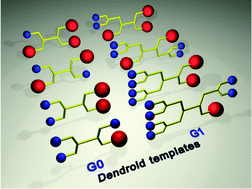Regio-specific size, shape and surface chemistry designed dendrimers based on differentiated dendroid templates†
Abstract
Various generations of zero α,ω-alkylenediamine core poly(amidoamine) PAMAM dendrimers (tetra-amine terminated substrates, A4) were allowed to react with sub-stoichiometric amounts (i.e., 2.0 equivalents) of Boc anhydride to give product mixtures consisting of the symmetrical tetra-Boc product (B4) and four partial Boc protected adducts, namely, (1) the tri-(AB3), (2) di-geminal (A2B2), (3) di-vicinal (A2B2) and (4) mono-Boc (A3B) products. These unprecedented, regio-differentiated Boc cores possess emerging dendritic features and intrinsic “protect–deprotect” function. We refer categorically to these newly differentiated branched cores as differentiated dendroid templates (DDT's). These dendroid templates can be well resolved by thin layer chromatography (TLC). Gram quantities of these Boc adducts were purified using single pass silica gel column chromatography. These partial Boc protected, differentiated dendroid templates (AmBn, m/n = 1–3) were used as “protect–deprotect” functionalized starting substrates (i.e., regio-differentiated cores) for synthesizing higher generation libraries of regio-differentiated PAMAM dendrimers. In principle, the use of differentiated dendroid templates (i.e., regio-functionalized star-branched cores) should be expected to offer broad options for the systematic engineering and control of many diverse organic nanostructures as a function of size, shape and regio-chemistry.


 Please wait while we load your content...
Please wait while we load your content...